Clay Ceramic Waste as Pozzolan Constituent in Cement for Structural Concrete
Abstract
1. Introduction
2. Materials and Methods
3. Results and Discussion
4. Suggestions for Future Work
- -
- Evaluation of the use of other percentages of CCW in the properties of the studied concrete. For example, using 5 or 15% of the waste as a substitute for cement;
- -
- Use of the plasticizer additive to reduce the water/cement (w/c) ratio, making it possible to obtain a concrete with superior strength, aiming to study how the CCW affects the properties of concrete with a lower w/c ratio;
- -
- Evaluation of the compactness of concrete using ceramic residue using techniques of porosometry, electrical resistivity or ultrasound;
- -
- Evaluation of the rheological properties of concrete containing CCW;
- -
- Evaluation of the durability of concretes containing CCW through high temperature tests, salt spray, ice–thaw cycles, immersion and drying tests and/or chloride attack;
- -
- Evaluation of the durability of concretes containing CCW in a situation of water and gas permeability;
- -
- Life cycle analysis of concretes containing CCW comparing them to concretes without incorporating waste;
- -
- Economic analysis, using the principles of circular economy, of the application of CCW as a substitute for cement in concrete.
5. Conclusions
Author Contributions
Funding
Institutional Review Board Statement
Informed Consent Statement
Data Availability Statement
Acknowledgments
Conflicts of Interest
References
- Zhao, Y.; Gao, J.; Liu, C.; Chen, X.; Xu, Z. The particle-size effect of waste clay brick powder on its pozzolanic activity and properties of blended cement. J. Clean. Prod. 2020, 242, 118521. [Google Scholar] [CrossRef]
- Hasani, M.; Tarighat, A. Proposing new pozzolanic activity index based on water adsorption energy via molecular dynamics simulations. Constr. Build. Mater. 2019, 213, 492–504. [Google Scholar] [CrossRef]
- De Azevedo, A.R.G.; Alexandre, J.; Zanelato, E.B.; Marvila, M.T. Influence of incorporation of glass waste on the rheological properties of adhesive mortar. Constr. Build. Mater. 2017, 148. [Google Scholar] [CrossRef]
- De Azevedo, A.R.G.; Marvila, M.T.; Barroso, L.S.; Zanelato, E.B.; Alexandre, J.; Xavier, G.C.; Monteiro, S.N. Effect of granite waste incorporation on the behavior of mortars. Materials 2019, 12, 1449. [Google Scholar] [CrossRef]
- Marvila, M.T.; Alexandre, J.; de Azevedo, A.R.G.; Zanelato, E.B. Evaluation of the use of marble waste in hydrated lime cement mortar based. J. Mater. Cycles Waste Manag. 2019. [Google Scholar] [CrossRef]
- Marvila, M.T.; Alexandre, J.; Azevedo, A.R.G.; Zanelato, E.B.; Xavier, G.C.; Monteiro, S.N. Study on the replacement of the hydrated lime by kaolinitic clay in mortars. Adv. Appl. Ceram. 2019, 118, 373–380. [Google Scholar] [CrossRef]
- Wang, Y.; Shui, Z.; Huang, Y.; Sun, T.; Yu, R.; Wang, G. Improving the pozzolanic activity of metakaolin by urea intercalation technique. Constr. Build. Mater. 2018, 172, 19–28. [Google Scholar] [CrossRef]
- Das, S.K.; Mishra, J.; Singh, S.K.; Mustakim, S.M.; Patel, A.; Das, S.K.; Behera, U. Characterization and utilization of rice husk ash (RHA) in fly ash–Blast furnace slag based geopolymer concrete for sustainable future. Mater. Today Proc. 2020. [Google Scholar] [CrossRef]
- Rattanachu, P.; Toolkasikorn, P.; Tangchirapat, W.; Chindaprasirt, P.; Jaturapitakkul, C. Performance of recycled aggregate concrete with rice husk ash as cement binder. Cem. Concr. Compos. 2020, 108, 103533. [Google Scholar] [CrossRef]
- Arif, E.; Clark, M.W.; Lake, N. Sugar cane bagasse ash from a high-efficiency co-generation boiler as filler in concrete. Constr. Build. Mater. 2017, 151, 692–703. [Google Scholar] [CrossRef]
- Jagadesh, P.; Ramachandramurthy, A.; Murugesan, R. Evaluation of mechanical properties of Sugar Cane Bagasse Ash concrete. Constr. Build. Mater. 2018, 176, 608–617. [Google Scholar] [CrossRef]
- Liu, Y.; Lei, S.; Lin, M.; Li, Y.; Ye, Z.; Fan, Y. Assessment of pozzolanic activity of calcined coal-series kaolin. Appl. Clay Sci. 2017, 143, 159–167. [Google Scholar] [CrossRef]
- Contrafatto, L. Recycled Etna volcanic ash for cement, mortar and concrete manufacturing. Constr. Build. Mater. 2017, 151, 704–713. [Google Scholar] [CrossRef]
- Siddique, R. Properties of concrete made with volcanic ash. Resour. Conserv. Recycl. 2012, 66, 40–44. [Google Scholar] [CrossRef]
- Feng, Y.; Yang, Q.; Chen, Q.; Kero, J.; Andersson, A.; Ahmed, H.; Engström, F.; Samuelsson, C. Characterization and evaluation of the pozzolanic activity of granulated copper slag modified with CaO. J. Clean. Prod. 2019, 232, 1112–1120. [Google Scholar] [CrossRef]
- Yao, G.; Liu, Q.; Wang, J.; Wu, P.; Lyu, X. Effect of mechanical grinding on pozzolanic activity and hydration properties of siliceous gold ore tailings. J. Clean. Prod. 2019, 217, 12–21. [Google Scholar] [CrossRef]
- dos Santos, V.; Tonoli, G.H.D.; Mármol, G.; Frías, M.; Savastano, H. Monitoring the dynamics of Portland cement hydration through photoluminescence and other correlated spectroscopy techniques. Constr. Build. Mater. 2020, 252, 119073. [Google Scholar] [CrossRef]
- Lu, Z.; Kong, X.; Jansen, D.; Zhang, C.; Wang, J.; Pang, X.; Yin, J. Towards a further understanding of cement hydration in the presence of triethanolamine. Cem. Concr. Res. 2020, 132, 106041. [Google Scholar] [CrossRef]
- Zhu, Z.; Xu, W.; Chen, H.; Tan, Z. Evolution of microstructures of cement paste via continuous-based hydration model of non-spherical cement particles. Compos. Part B Eng. 2020, 185, 107795. [Google Scholar] [CrossRef]
- Ismail, A.H.; Kusbiantoro, A.; Chin, S.C.; Muthusamy, K.; Islam, M.; Tee, K.F. Pozzolanic reactivity and strength activity index of mortar containing palm oil clinker pretreated with hydrochloric acid. J. Clean. Prod. 2020, 242, 118565. [Google Scholar] [CrossRef]
- Tironi, A.; Cravero, F.; Scian, A.N.; Irassar, E.F. Pozzolanic activity of calcined halloysite-rich kaolinitic clays. Appl. Clay Sci. 2017, 147, 11–18. [Google Scholar] [CrossRef]
- Fu, Q.; Yan, L.; Ning, T.; Wang, B.; Kasal, B. Behavior of adhesively bonded engineered wood–Wood chip concrete composite decks: Experimental and analytical studies. Constr. Build. Mater. 2020, 247, 118578. [Google Scholar] [CrossRef]
- Du, H.; Hu, X.; Sun, Z.; Meng, Y.; Han, G. Load carrying capacity of inclined crossing screws in glulam-concrete composite beam with an interlayer. Compos. Struct. 2020, 112333. [Google Scholar] [CrossRef]
- ABNT NBR. 16697: Portland Cement-Requirements; ABNT: São Paulo, Brazil, 2018. (In Portuguese) [Google Scholar]
- Azevedo, A.R.G.; França, B.R.; Alexandre, J.; Marvila, M.T.; Zanelato, E.B.; Xavier, G.C. Influence of sintering temperature of a ceramic substrate in mortar adhesion for civil construction. J. Build. Eng. 2018, 19. [Google Scholar] [CrossRef]
- Azevedo, A.R.G.; Vieira, C.M.F.; Ferreira, W.M.; Faria, K.C.P.; Pedroti, L.G.; Mendes, B.C. Potential use of ceramic waste as precursor in the geopolymerization reaction for the production of ceramic roof tiles. J. Build. Eng. 2020, 29, 101156. [Google Scholar] [CrossRef]
- Rashid, K.; Razzaq, A.; Ahmad, M.; Rashid, T.; Tariq, S. Experimental and analytical selection of sustainable recycled concrete with ceramic waste aggregate. Constr. Build. Mater. 2017, 154, 829–840. [Google Scholar] [CrossRef]
- Ogawa, Y.; Bui, P.T.; Kawai, K.; Sato, R. Effects of porous ceramic roof tile waste aggregate on strength development and carbonation strength of steam-cured fly ash concrete. Constr. Build. Mater. 2020, 236, 117462. [Google Scholar] [CrossRef]
- Huseien, G.F.; Sam, A.R.M.; Shah, K.W.; Mirza, J. Effects of ceramic tile powder waste on properties of self-compacted alkali-activated concrete. Constr. Build. Mater. 2020, 236, 117574. [Google Scholar] [CrossRef]
- Keshavarz, Z.; Mostofinejad, D. Porcelain and red ceramic wastes used as replacements for coarse aggregate in concrete. Constr. Build. Mater. 2019, 195, 218–230. [Google Scholar] [CrossRef]
- Bommisetty, J.; Keertan, T.S.; Ravitheja, A.; Mahendra, K. Effect of waste ceramic tiles as a partial replacement of aggregates in concrete. Mater. Today Proc. 2019, 19, 875–877. [Google Scholar] [CrossRef]
- Zareei, S.A.; Ameri, F.; Bahrami, N.; Shoaei, P.; Musaeei, H.R.; Nurian, F. Green high strength concrete containing recycled waste ceramic aggregates and waste carpet fibers: Mechanical, durability, and microstructural properties. J. Build. Eng. 2019, 26, 100914. [Google Scholar] [CrossRef]
- Medina, C.; Sánchez de Rojas, M.I.; Thomas, C.; Polanco, J.A.; Frías, M. Durability of recycled concrete made with recycled ceramic sanitary ware aggregate. Inter-indicator relationships. Constr. Build. Mater. 2016, 105, 480–486. [Google Scholar] [CrossRef]
- Kannan, D.M.; Aboubakr, S.H.; EL-Dieb, A.S.; Reda Taha, M.M. High performance concrete incorporating ceramic waste powder as large partial replacement of Portland cement. Constr. Build. Mater. 2017, 144, 35–41. [Google Scholar] [CrossRef]
- Irassar, E.; Rahhal, V.; Tironi, A.; Trezza, M.; Zbyšek Pavlík, M.; Pavlíková, M.; Jerman, R.C. Utilization of ceramic wastes as pozzolanic materials. In Clean Technology 2014: Energy, Renewables, Environment & Materials; CRC Press: Boca Raton, FL, USA, 2014; pp. 316–319. [Google Scholar]
- Pokorný, J.; Fořt, J.; Pavlíková, M.; Studnička, J.; Pavlík, Z. Application of Mixed Ceramic Powder in Cement Based Composites. Adv. Mater. Res. 2014, 1054, 177–181. [Google Scholar] [CrossRef]
- Vejmelková, E.; Koňáková, D.; Kulovaná, T.; Hubáček, A.; Černý, R. Mechanical and Thermal Properties of Moderate-Strength Concrete with Ceramic Powder Used as Supplementary Cementitious Material. Adv. Mater. Res. 2014, 1054, 194–198. [Google Scholar] [CrossRef]
- Cheng, Y.; Huang, F.; Li, G.; Xu, L.; Hou, J. Test research on effects of ceramic polishing powder on carbonation and sulphate-corrosion strength of concrete. Constr. Build. Mater. 2014, 55, 440–446. [Google Scholar] [CrossRef]
- Cheng, Y.; Huang, F.; Liu, R.; Hou, J.; Li, G. Test research on effects of waste ceramic polishing powder on the permeability strength of concrete. Mater. Struct. 2016, 49, 729–738. [Google Scholar] [CrossRef]
- Pacheco-Torgal, F.; Jalali, S. Compressive strength and durability properties of ceramic wastes based concrete. Mater. Struct. 2011, 44, 155–167. [Google Scholar] [CrossRef]
- Reiterman, P.; Holčapek, O.; Čáchová, M.; Vogel, F.; Jogl, M.; Konvalinka, P. Basic and Hygric Properties of Concrete Containing Fine Ceramic Powder. Adv. Mater. Res. 2014, 897, 188–191. [Google Scholar] [CrossRef]
- Wang, G.; Tian, B. Effect of Waste Ceramic Polishing Powder on the Properties of Cement Mortars. In Proceedings of the 2009 International Conference on Energy and Environment Technology, Guilin, China, 16–18 October 2009; pp. 101–104. [Google Scholar]
- Romano, R.C.O.; Fujii, A.L.; Souza, R.B.; Takeashi, M.S.; Pileggi, R.G.; Cincotto, M.A. Acompanhamento da hidratação de cimento Portland simples com resíduo de bauxita. Cerâmica 2016, 62, 215–223. [Google Scholar] [CrossRef][Green Version]
- Collier, N.C.; Sharp, J.H.; Milestone, N.B.; Hill, J.; Godfrey, I.H. The influence of water removal techniques on the composition and microstructure of hardened cement pastes. Cem. Concr. Res. 2008, 38, 737–744. [Google Scholar] [CrossRef]
- Azevedo, A.R.G.; Alexandre, J.; Petrucci, L.J.T.; Zanelato, E.B.; Oliveira, T.F. Evaluation of the Pozzolanic Activity of Waste from the Paper Industry; Springer International Publishing: San Diego, CA, USA, 2017; Volume Part F7, ISBN 9783319513812. [Google Scholar]
- Azevedo, A.R.G.; Marvila, T.M.; Júnior Fernandes, W.; Alexandre, J.; Xavier, G.C.; Zanelato, E.B.; Cerqueira, N.A.; Pedroti, L.G.; Mendes, B.C. Assessing the potential of sludge generated by the pulp and paper industry in assembling locking blocks. J. Build. Eng. 2019. [Google Scholar] [CrossRef]
- ABNT-Brazilian Association of Technical Standards ABNT NBR 16889-Fresh Concrete—Slump Test; ABNT: São Paulo, Brazil, 2020. (In Portuguese)
- ABNT NBR 5738:2015-Concrete-Procedure for Molding and Curing Concrete Test Specimens; Brazilian Association of Technical Standards; ABNT: São Paulo, Brazil, 2015. (In Portuguese)
- ABNT NBR 5739: Concrete-Cylindrical Specimen Compression Test; Brazilian Association of Technical Standards; ABNT: São Paulo, Brazil, 2018. (In Portuguese)
- ABNT NBR 9778–Mortar and Hardened Concrete-Determination of Water Absorption, Voids Index and Specific Gravity; Brazilian Association of Technical Standards; ABNT: São Paulo, Brazil, 2011. (In Portuguese)
- ABNT ABNT NBR 13280-Mortar for Laying and Cladding Walls and Ceilings-Determination of Bulk Density in the Hardened State; Brazilian Association of Technical Standards; ABNT: São Paulo, Brazil, 2005. (In Portuguese)
- ABNT NBR 15259-Mortar for Laying and Cladding Walls and Ceilings-Determination of Water Absorption by Capillarity and Capillarity Coefficient; Brazilian Association of Technical Standards; ABNT: São Paulo, Brazil, 2005. (In Portuguese)
- ABNT NBR 12653-Pozzolanic Materials; Brazilian Association of Technical Standards; ABNT: São Paulo, Brazil, 2014. (In Portuguese)
- ABNT NBR 6118-Concrete Structures Project-Procedure; Brazilian Association of Technical Standards; ABNT: São Paulo, Brazil, 2014. (In Portuguese)
- Mittri, S.H.M.; Degen, M.K.; Vieira, G.L.; Vazzoler, J.S.; Rodrigues, L.H.C.H. Assessment of the pozzolanic activity of ornamental stone waste after heat treatment and its effect on the mechanical properties of concretes. Rev. IBRACON Estrut. Mater. 2018, 11, 1186–1207. [Google Scholar] [CrossRef]
- Cerutti, R.M.; Santos, S.H.C. Impacts in the structural design of the 2014 revision of the brazilian standard ABNT NBR 6118. Rev. IBRACON Estrut. Mater. 2015, 8, 547–566. [Google Scholar] [CrossRef]
- Marvila, M.T.; Azevedo, A.R.G.; Alexandre, J.; Zanelato, E.B.; Azeredo, N.G.; Simonassi, N.T.; Monteiro, S.N. Correlation between the properties of structural clay blocks obtained by destructive tests and Ultrasonic Pulse Tests. J. Build. Eng. 2019, 26, 56–74. [Google Scholar] [CrossRef]

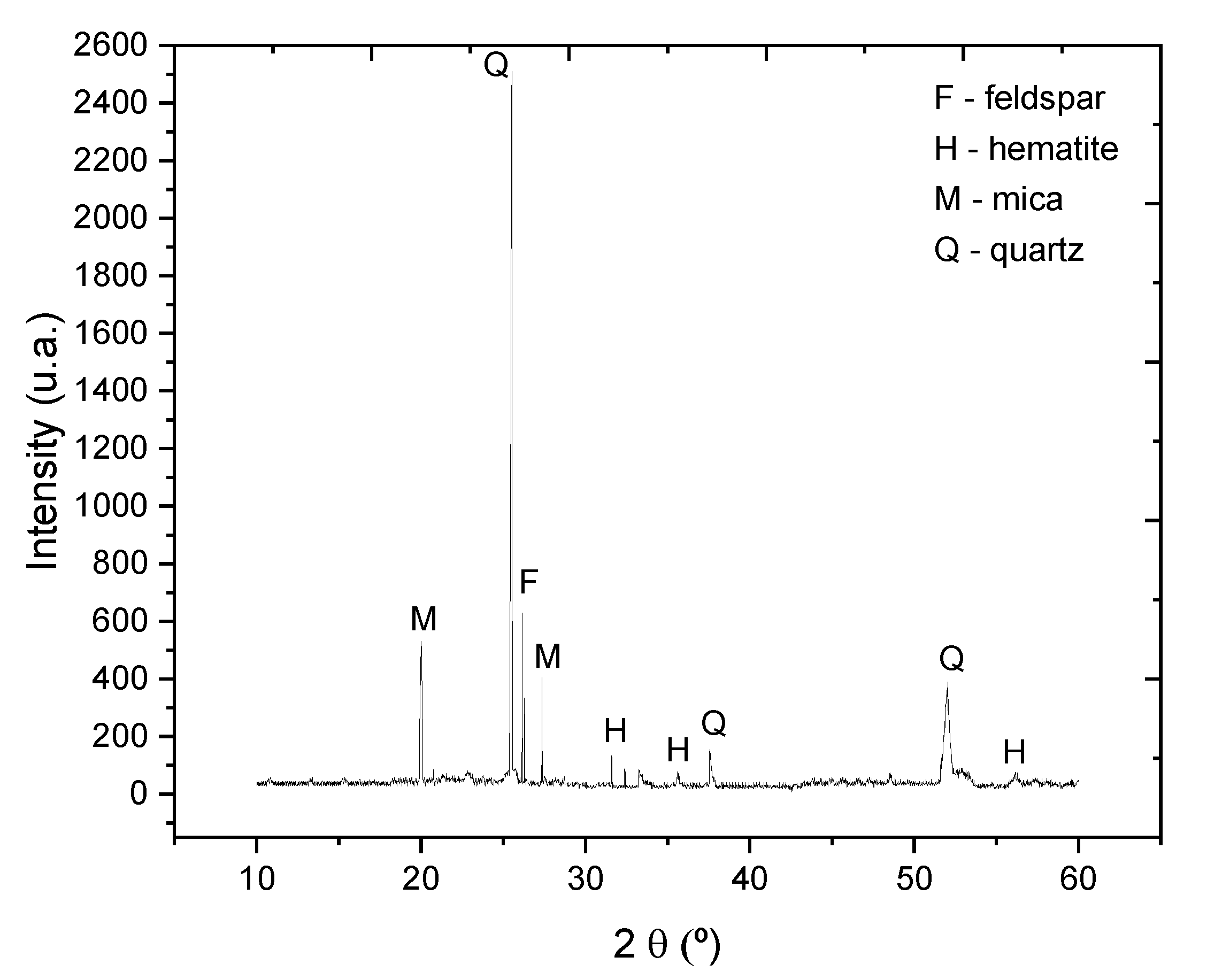
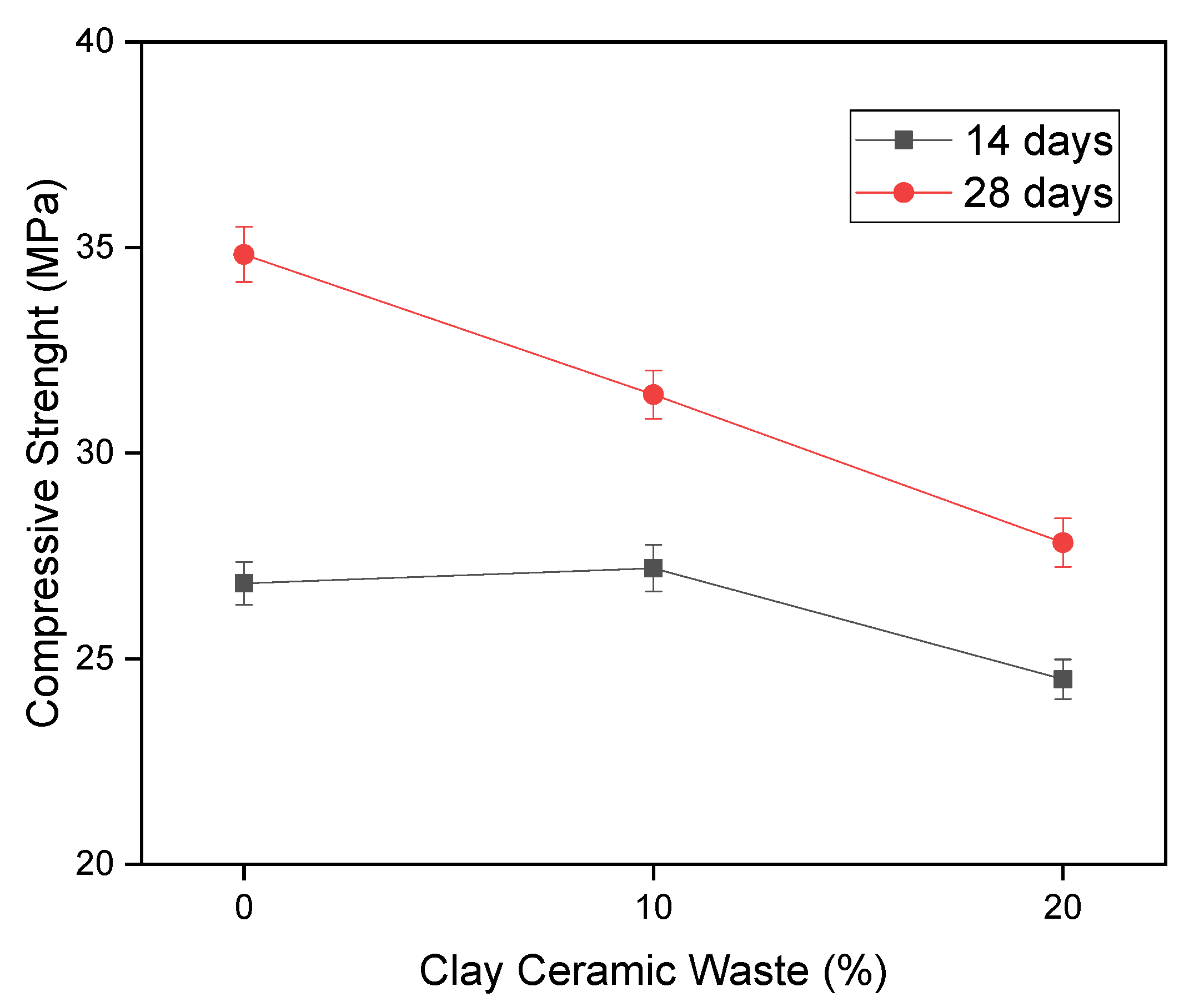
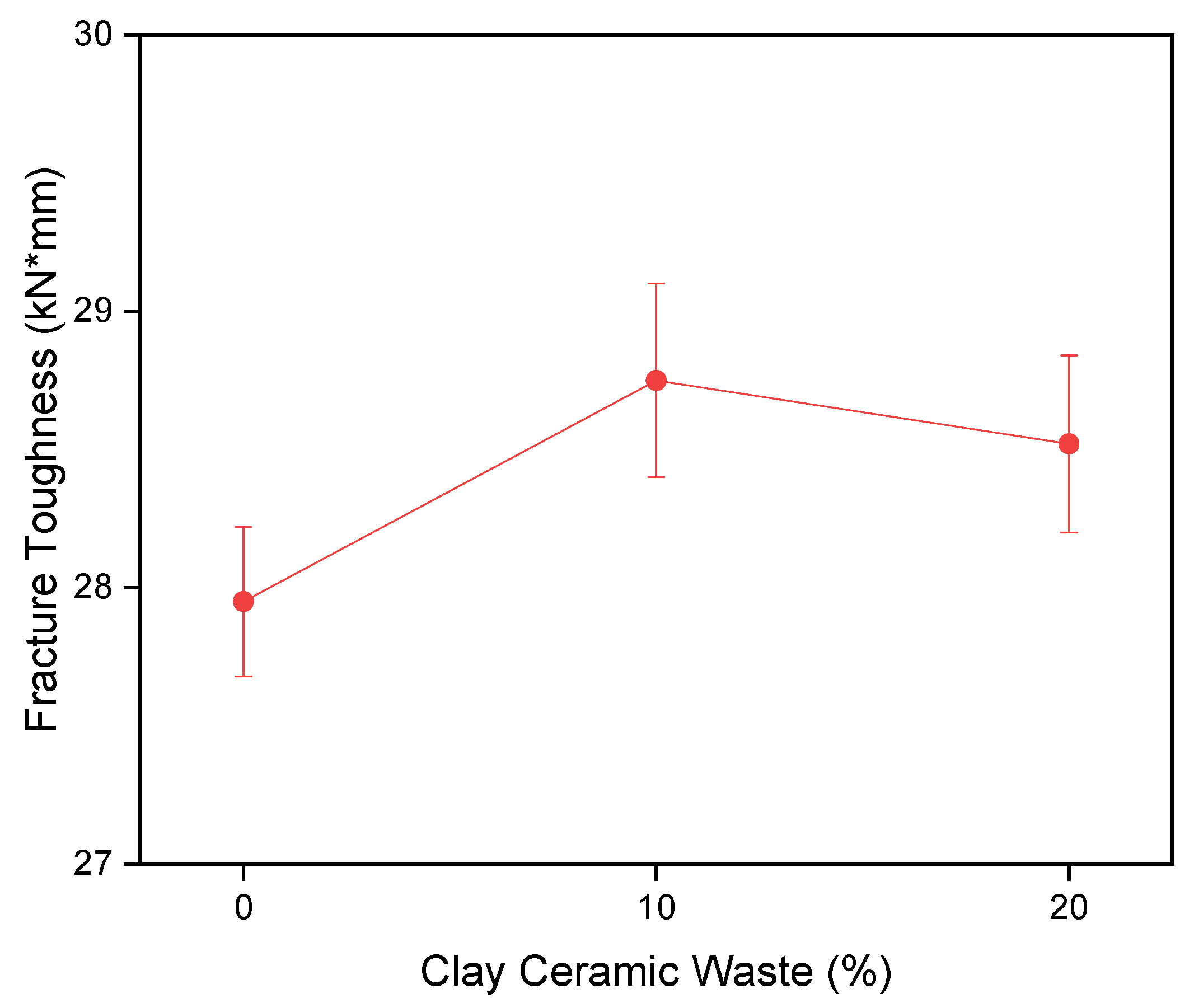
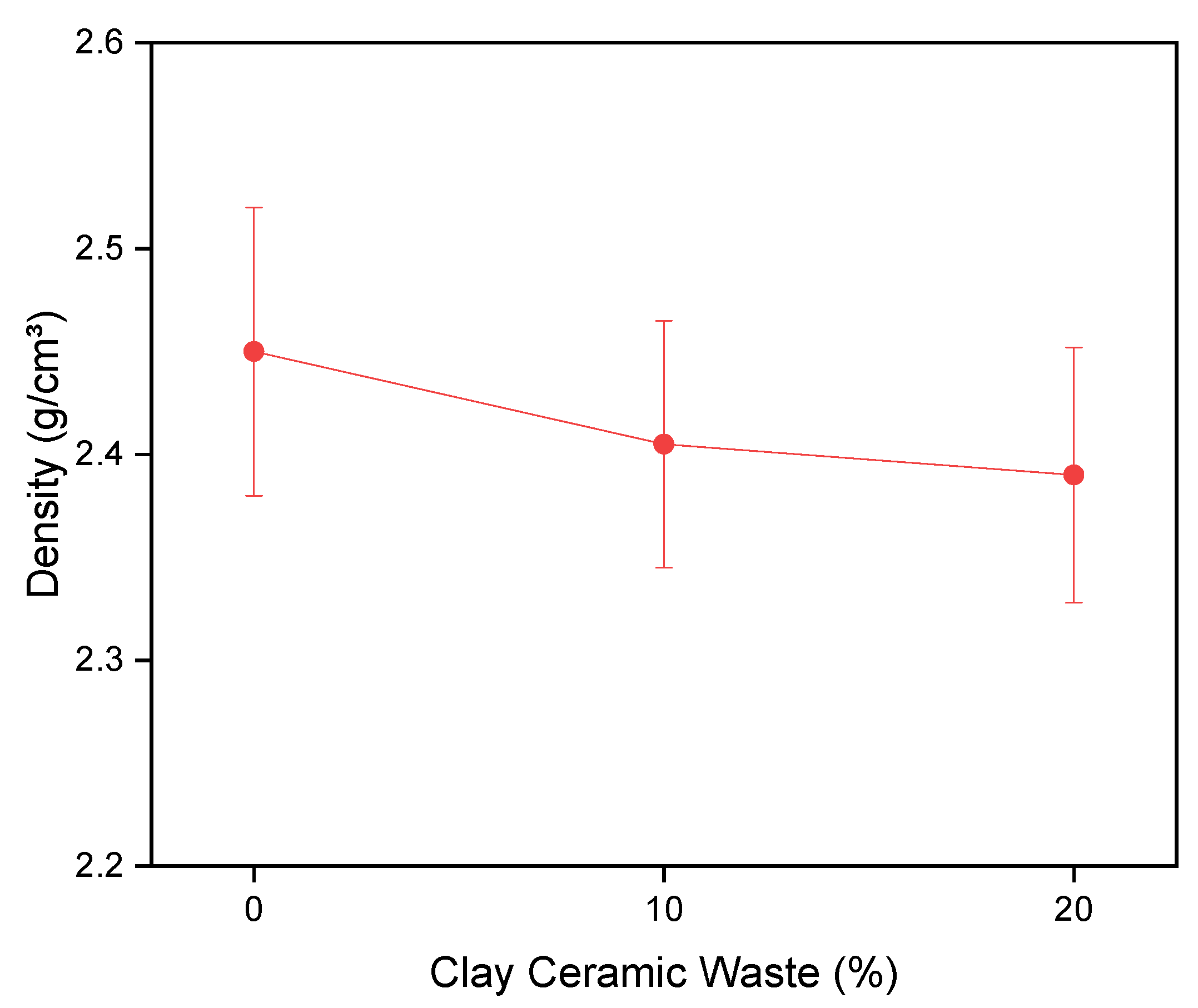
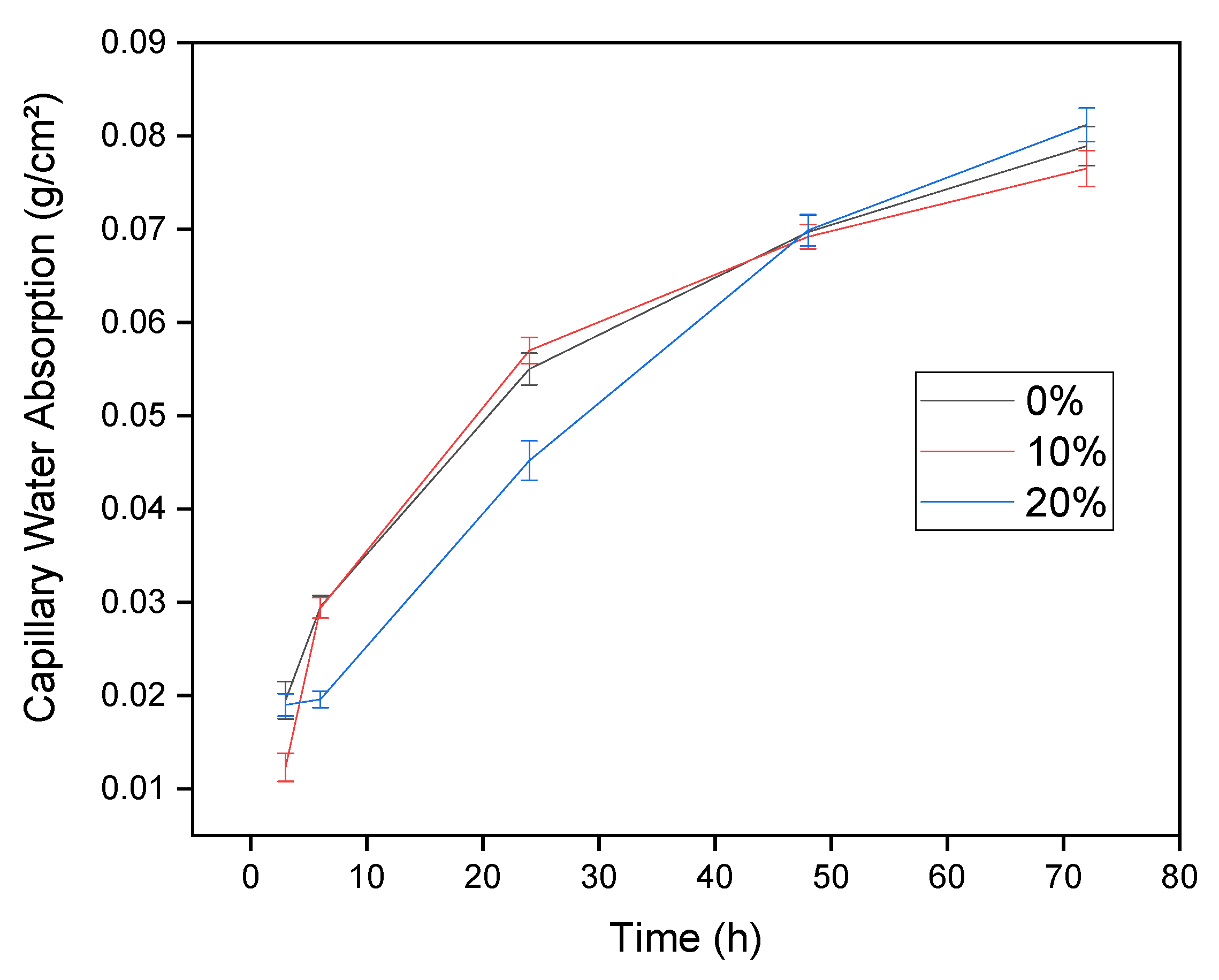
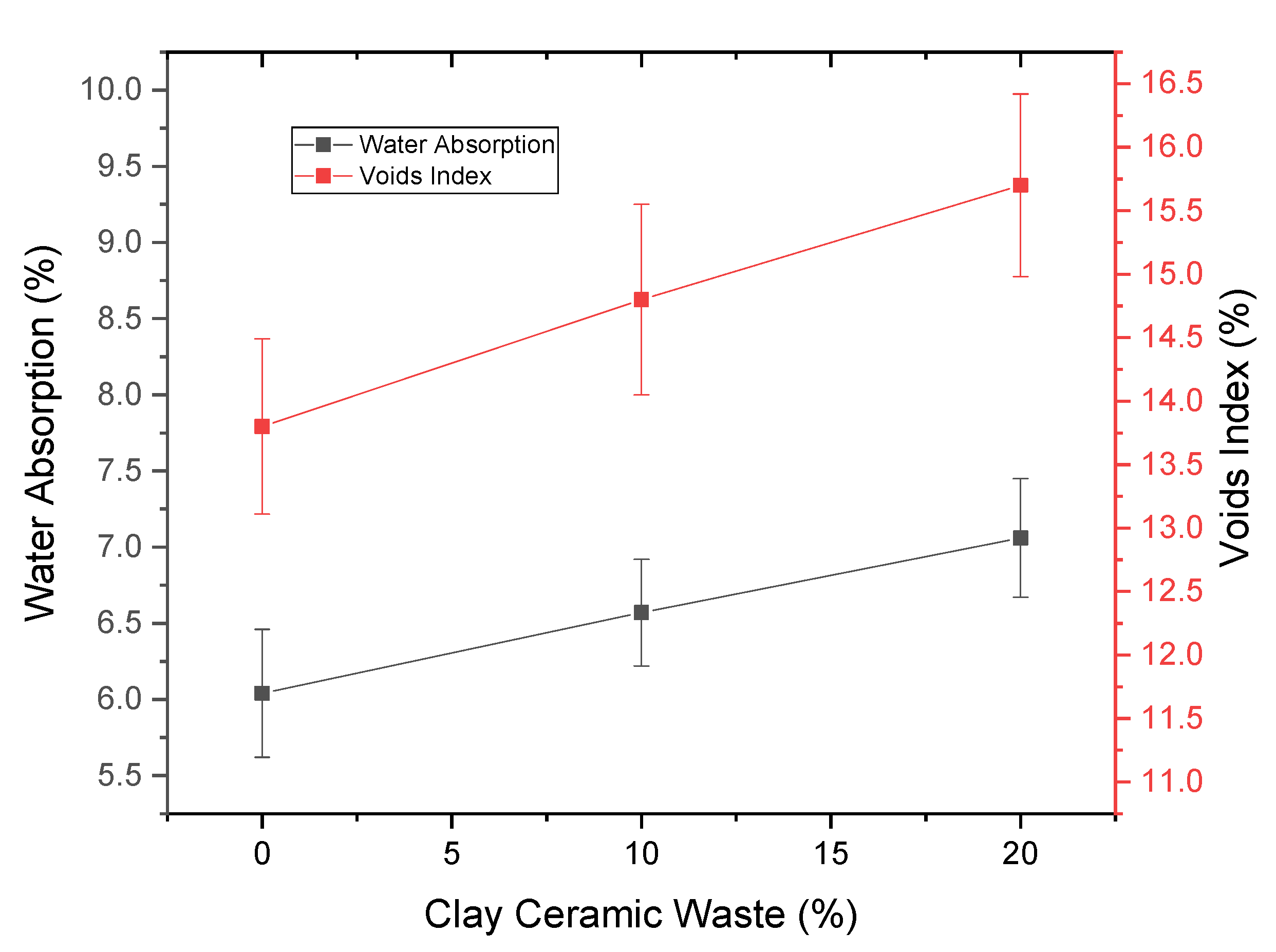
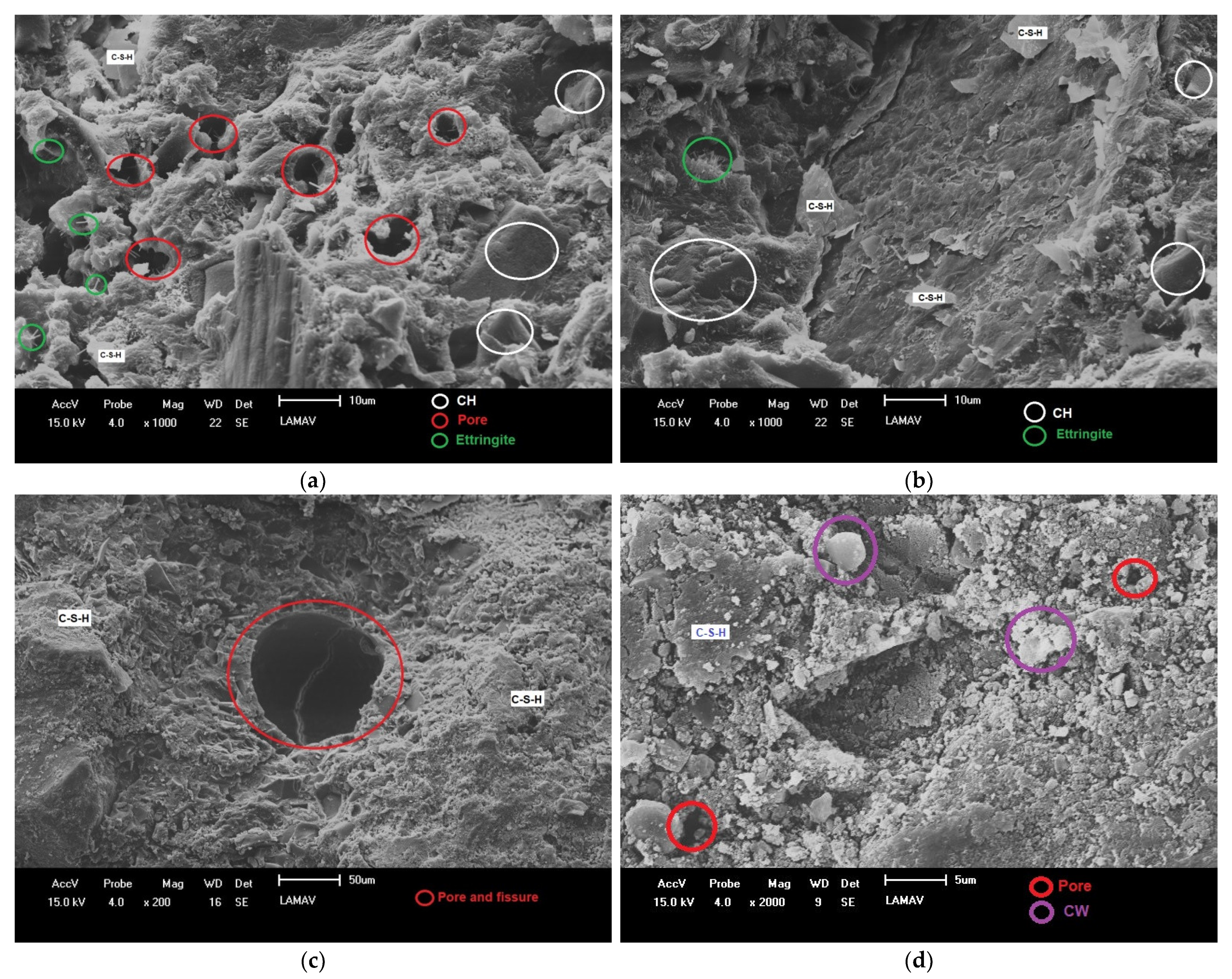
| Authors | Waste Characteristics | Properties | Pozzolanicity Test | Percentage Replaced | Conclusions about Mechanical Strength |
|---|---|---|---|---|---|
| Kannan et al. (2017) [34] | Waste extracted from polishing ceramic glazes containing silica and alumina. (69.4% SiO2; 18.2% Al2O3; 3.53% MgO; 3.19% Na2O) | Compressive strength, permeability, X-ray Diffraction (XRD) and Magic Angle Spinning Nuclear Magnetic Resonance (MAS-NMR). | Frattini test | 0, 10, 20, 30, 40% | The compressive strength dropped from 63.8 (0%) to 57.5 (10%), 52.3 (20%), 49 (30%) and 42.6 MPa (40%), concluding that the percentages of 30% and 40% of the waste are harmful to strength. |
| Irassar et al. (2014) [35] | Waste extracted from an Argentine ceramic containing quartz, feldspar, anortite and hematite. (51.3% SiO2; 20% Al2O3; 11.5% CaO; 6% Fe2O3; 3.2% K2O) | Calorimetry and XRD. | Frattini test | 8, 16, 24, 32, 40% | They did not evaluate the mechanical strength, only the kinetics of the reactions. |
| Pokorný et al. (2014) [36] | Waste extracted from a Spanish ceramic block industry containing gypsum, quartz, microclimate, albite, muscovite and smaller amounts of hematite (37% SiO2; 14.28% Al2O3; 11.14% CaO; 4.77% Fe2O3; 17.9% SO3) | Compressive strength, porosity, density, thermal conductivity. | Unrealized | 0, 8, 16, 24, 32% | The compressive strength values were: 59.4 (0%), 45.7 (10%), 43.9 (16%), 26.6 (24%) and 21.7 MPa (32%). There was a high reduction in strength to 24% and 32% due to the presence of gypsum, eliminating the possibility of using these percentages. |
| Vejmelková et al. (2014) [37] | Ground brick waste from the production of thermal insulating blocks (54.97% SiO2; 14.3% Al2O3; 15.2% CaO; 4.8% Fe2O3) | Compressive strength, porosity, density, thermal conductivity. | Unrealized | 0, 10, 20, 40, 60% | The compressive strength values were: 43 (0%), 41.2 (10%), 40.1 (20%), 26.9 (40%) and 24.5 MPa (60%). The percentages of 40% and 60% were discarded due to the high drop in strength. |
| Cheng et al. (2014) [38] | Ceramic polishing waste extracted from a Chinese industry composed of quartz and mullite (69.02% SiO2; 16.04% Al2O3; 4.08% MgO; 3.15% Na2O) | Compressive strength and durability tests (acid attack), XRD and Scanning Electron Microscope (SEM). | Unrealized | 0, 10, 20, 30, 40% | The strength dropped from 45.5 to 44.68 (10%), 41.35 (20%), 33.19 (30%) and 32.97 (40%). An excessive drop is observed for the compositions of 30% and 40%. |
| Cheng et al. (2016) [39] | Ceramic polishing waste extracted from a Chinese industry composed of quartz and mullite (69.02% SiO2; 16.04% Al2O3; 4.08% MgO; 3.15% Na2O) | Compressive strength and chloride permeability tests, XRD, SEM and Energy-dispersive X-ray Spectroscopy (EDS). | Unrealized | 0, 10, 20, 30, 40% | The strength dropped from 45.5 to 44.68 (10%), 41.35 (20%), 33.19 (30%) and 32.97 (40%). An excessive drop is observed for the compositions of 30% and 40%. |
| Pacheco-Torgal and Jalali (2011) [40] | Ceramic waste from burnt bricks composed of quartz and hematite, calcite, cristobaltite and feldspar in smaller quantities. (51.7% SiO2; 18.2% Al2O3; 6.1% Fe2O3; 6.1% CaO) | Compressive strength, porosity, water absorption, oxygen and water permeability, durability in attack by chlorides. | Unrealized | 0 and 20% | The strength results obtained for concrete with 20% were excellent (39.7 MPa) when compared to the reference composition (40.4 MPa). |
| Reiterman et al. (2014) [41] | Ceramic waste is not characterized. | Compressive strength, density, acid attack durability. | Unrealized | 0, 5, 10, 15, 20, 25, 30%. | Strength values: 61 (0%); 64.3 (5%); 62.9 (10%); 59.5 (15%), 58.8 (20%), 51.8 (25%) and 46.2 (30%). A considerable drop in strength is observed to 25% and 30%. |
| Wang (2009) [42] | Ceramic waste is not characterized. | Compressive strength, linear shrinkage, heat of hydration, porosity, SEM. | Unrealized | 0, 10, 20, 50%. | Strength values: 55.6 (0%), 49.8 (10%), 46.5 (20%) and 32.5 (50%). There is a high reduction in strength for the composition of 50%. |
| SiO2 | A2O3 | Fe2O3 | K2O | Na2O | TiO2 | P2O5 | CaO |
|---|---|---|---|---|---|---|---|
| 56.80 | 32.30 | 3.70 | 1.60 | 0.70 | 1.10 | 0.25 | 0.98 |
| Concrete | Portland Cement | Fine Aggregate | Coarse Aggregate | Clay Ceramic Waste | Water/Cement | Slump Teste (cm) |
|---|---|---|---|---|---|---|
| C0% | 1.00 | 1.38 | 2.95 | 0.00 | 0.49 | 70 ± 10 |
| C10% | 0.90 | 1.38 | 2.95 | 0.10 | 0.54 | |
| C20% | 0.80 | 1.38 | 2.95 | 0.20 | 0.61 |
| Information | Result |
|---|---|
| Initial conductivity | 7.18 |
| Final conductivity | 8.39 |
| Conductivity variation | 1.21 |
| Classification | High pozzolanicity |
Publisher’s Note: MDPI stays neutral with regard to jurisdictional claims in published maps and institutional affiliations. |
© 2021 by the authors. Licensee MDPI, Basel, Switzerland. This article is an open access article distributed under the terms and conditions of the Creative Commons Attribution (CC BY) license (https://creativecommons.org/licenses/by/4.0/).
Share and Cite
Barreto, E.d.S.; Stafanato, K.V.; Marvila, M.T.; de Azevedo, A.R.G.; Ali, M.; Pereira, R.M.L.; Monteiro, S.N. Clay Ceramic Waste as Pozzolan Constituent in Cement for Structural Concrete. Materials 2021, 14, 2917. https://doi.org/10.3390/ma14112917
Barreto EdS, Stafanato KV, Marvila MT, de Azevedo ARG, Ali M, Pereira RML, Monteiro SN. Clay Ceramic Waste as Pozzolan Constituent in Cement for Structural Concrete. Materials. 2021; 14(11):2917. https://doi.org/10.3390/ma14112917
Chicago/Turabian StyleBarreto, Everton dos Santos, Karina Vaz Stafanato, Markssuel Teixeira Marvila, Afonso Rangel Garcez de Azevedo, Mujahid Ali, Ronald Matheus Lobo Pereira, and Sérgio Neves Monteiro. 2021. "Clay Ceramic Waste as Pozzolan Constituent in Cement for Structural Concrete" Materials 14, no. 11: 2917. https://doi.org/10.3390/ma14112917
APA StyleBarreto, E. d. S., Stafanato, K. V., Marvila, M. T., de Azevedo, A. R. G., Ali, M., Pereira, R. M. L., & Monteiro, S. N. (2021). Clay Ceramic Waste as Pozzolan Constituent in Cement for Structural Concrete. Materials, 14(11), 2917. https://doi.org/10.3390/ma14112917









